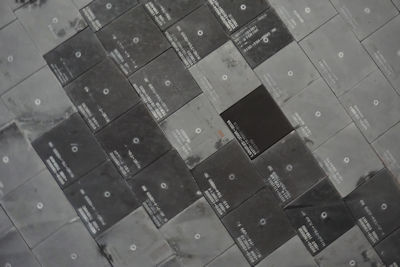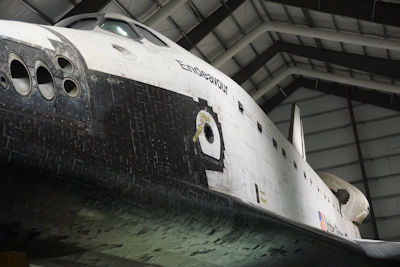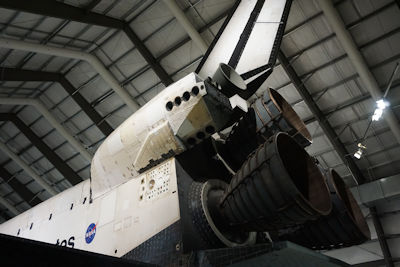
During the weekend of October 12, 2012, residents of Los Angeles lined the streets of their city in anticipation of a spectacle that had never been seen before – the Space Shuttle Endeavour winding its way down highways and through neighborhoods as the craft made its way from Los Angeles International Airport to the California Science Center in Exhibition Park.
Endeavour completed its final mission to the International Space Station a mere sixteen months earlier, on June 1, 2011, its twenty-fifth flight overall. During its nineteen years of service, Endeavour flew 122,833,151 miles and spent 299 days in space. The craft carried the first female African American astronaut – Mae Jemison – into the outer reaches of Earth’s atmosphere in September 1992, and was the first Space Shuttle to service the Hubble Space Telescope in 1993.
When the end of the Space Shuttle program was announced by President George W. Bush in 2003, it was decided that the remaining Shuttles would be given to museums around the country after they had been retired. The original test shuttle, Enterprise, was already on display at the Smithsonian National Air and Space Museum but the fate of the additional three crafts – Atlantis, Discovery, and Endeavour – was left to NASA administrator Charles F. Bolden Jr. to decide.
Cities from New York to Seattle, Chicago to Houston, all threw their names into the hat and made pitches as to why they should be selected. A total of twenty-one museums entered the unofficial competition, with the Kennedy Space Center in Florida, the Intrepid Sea, Air & Space Museum in New York City, and the California Science Center being selected as the permanent homes of the remaining Space Shuttle fleet.
In many ways, Los Angeles was an obvious choice. Congress had authorized the construction of Endeavour in 1987 as a replacement for the Space Shuttle Challenger, which had been lost in a tragic accident shortly after liftoff a year earlier. Like all of the shuttles, large sections of Endeavour were manufactured in California – including the crew compartment and fuselage – and the various pieces of the craft were then assembled in Palmdale, California, by Rockwell International.
The Rocketdyne Operations Support Center in Canoga Park, California, monitored the main engines during every Space Shuttle launch since the program’s inception, while the original shuttle Enterprise undertook its initial series of test flights at the Edwards Air Force Base in Kern County, California.
Upon its arrival at the California Science Center in October 2012, Endeavour was rolled into the Samuel Oschin Pavilion where it officially went on display at the end of that month. “This is the launch of a new mission for Endeavour to inspire the next generation of explorers,” NASA associate administrator and former Space Shuttle astronaut Leland Melvin declared at the exhibit’s opening. “The students, parents, teachers and attendees celebrated this addition to this community and to California’s focus on science, technology, engineering and mathematics.”
Endeavour was initially positioned horizontally raised within the Samuel Oschin Pavilion until a new facility could be constructed and the Shuttle shifted vertically to mimic its appearance on the launch pad. The horizontal positioning allowed visitors to walk the entire length of the craft and observe the wear-and-tear that space travel had on the shuttle, as well as saunter underneath Endeavour and gaze at the thermal protection tiles on its underbelly – each of which is numbered and engineered differently to not only fit together but handle the extreme temperatures expected during re-entry.
In addition to the Space Shuttle Endeavour itself, the California Science Center in Los Angeles has other shuttle artifacts on display as well. Endeavour’s SPACEHUB Logistics Module – originally installed in the payload bay in order to give astronauts extra room to live and work – is likewise located in the Samuel Oschin Pavilion, along with the Space Shuttle’s main engine.
Inside the actual California Science Center, meanwhile, is the galley from Endeavour that astronauts used to prepare their meals, the monitoring room from the Rocketdyne Operations Support Center, and the tires used on Endeavour’s final mission in 2011.
While Endeavour may be the centerpiece of the California Science Center’s exhibit on space travel, it is not the only craft on display as the center also contains original capsules from all three of NASA’s previous programs – Mercury, Gemini, and Apollo.
The featured Mercury capsule was used to send the chimpanzee Ham into space on January 31, 1961, a prelude to Alan Shepard’s own flight four months later. The Gemini capsule, meanwhile, was launched in September 1966 with astronauts Charles Conrad and Richard Gordon onboard, and Apollo is represented with the capsule that contained Thomas Stafford, Vance Brand, and Donald “Deke” Slayton on their historic rendezvous with the Soviet Union’s Soyuz spacecraft in July 1975.
The Space Shuttle program was officially announced in 1972, a continuation of the efforts of Mercury, Gemini, and Apollo that featured a reusable craft capable of carrying satellites into space and building an International Space Station that would orbit the Earth and become the base of operation for future exploration.
The first Space Shuttle mission began on April 12, 1981 – exactly twenty years after cosmonaut Yuri Gagarin became the first human to travel beyond Earth’s atmosphere – and a total of 135 Space Shuttle missions followed until the final launch in July 2011. The Space Shuttle program contained many highs in the history of space travel, opening space exploration to not only white males but women, African Americans, Canadians, Japanese, and even married couples.
The Space Shuttle initiative also witnessed the American space program’s two worst disasters – Challenger exploded shortly after liftoff in 1986 and Columbia disintegrated as it returned to Earth in 2003. Fourteen astronauts lost their lives in those twin tragedies, a stark reminder of the perilous nature of space exploration that likewise elicited a renewed determination to ensure that those who perished had not died in vain.
The Space Shuttle Endeavour is an emblem of that determination, a promise from the past made to the future that the human race will continue to explore both the inner reaches and outer reaches of space. Only four Space Shuttles remain intact, and although each of them was decommissioned years ago, they still inspire new generations to take the mantle and continue the dream of those who came before them.
Anthony Letizia





